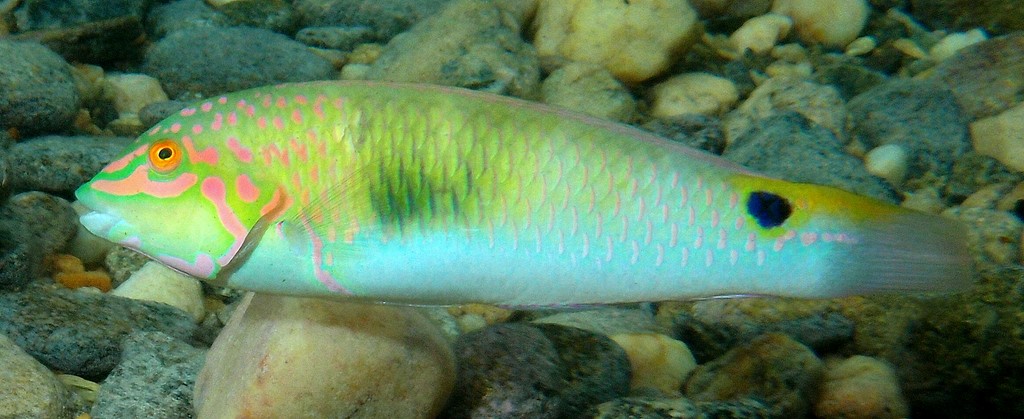HALICHOERES TRIMACULATUS - (QUOY & GAIMARD, 1834)
Actinopterygii (Gigaclass) > Actinopteri (Class) > Teleostei (Subclass) > Labriformes (Order) > Labroidei (Suborder) > Labridae (Family) > Halichoeres (Genus)
Labre à trois taches, Spotted-tail rainbowfish, Three-spot rainbowfish, Three-spot wrasse, Spotted-tail rainbow-fish, Doppelfleck-Junker, Mitsuboshi-kyusen, ミツボシキュウセン, 三斑海猪鱼,
Synonymes
Guntheria vestalis (Whitley, 1958)
Halichoeres spilurus (Bleeker, 1851)
Hemitautoga trimaculata (Quoy & Gaimard 1834)
Julis auritus (Valenciennes, 1839)
Julis spilurus (Bleeker, 1851)
Julis trimaculata (Quoy & Gaimard, 1834)
Julis trimaculatus (Valenciennes, 1839)
Platyglossus vicinus (Günther, 1909)
-----------------------
Description
Dorsal spines (total): 9; Dorsal soft rays (total): 11; Anal spines: 3; Anal soft rays: 10-11 (usually: 11); Pectoral fin rays: 14-15 (usually: 14); Lateral line scales: 27, the anterior scales with one pore; Two pairs of projecting canine teeth at front of upper jaw, the second pair about half as long and recurved; One pair of canines anterioly in lower jaw. Max. length: 27.0 cm TL. Depth range: 2 - 30 m, usually: 2 - 18 m.
Color
Initial phase: greenish-yellow body with pink-rimmed scales. There is usually a large black spot surrounded by yellow on the top of the caudal fin base. There is a smaller black spot on the pectoral fin base.
Terminal phase: males are similar in color, but have an additional black mark below the first part of the dorsal fin. The head has irregular pink and green markings and the black spot on the caudal peduncle is more obvious than in initial phase fish. The caudal fin may be completely yellow.
Etymology
Halichoeres: from Greek, halio-, hali-, halo-, hal- = word-forming element meaning "salt, sea," a Greek combination form of hals (genitive halos) "a lump of salt, salt generally," in Homer, "the sea," + from Greek, choiros = pig. Referring to elongated conical tooth at each corner of mouth, pointed outwards and forwards, and usually protruding beyond the flesh of lips, which reminded Rüppell of the canine teeth of a boar; Here "hog of the sea or hogfish".
trimaculatus: from Latin, tres = three + from Latin, macula = spot, stain. Refers to the fish's three spots.
Original description: Julis trimaculata Quoy & Gaimard, 1834 - Type locality: Vanikoro Island, Santa Cruz Islands, southwestern Pacific.
Distribution
Eastern Indian Ocean, western Pacific: Christmas and Cocos-Keeling islands, east to Line Islands and Tuamotu islands, north to Japan, south to Australia and New Caledonia.
Biology
Inhabits sandy areas of reef flats, lagoons, and semi-protected seaward reefs. Juveniles shallow in protected coastal waters. Feeds on sand and rubble dwelling invertebrates (crustaceans, mollusks, forams, polychaetes, fish eggs, and small fishes). Has the habit of following sand-disturbing fishes such as goatfishes in order to intercept escaping prey. Bi-directional sex change has been confirmed for this species. Distinct pairing during breeding.
Last update: 30, March 2023
Labre à trois taches, Spotted-tail rainbowfish, Three-spot rainbowfish, Three-spot wrasse, Spotted-tail rainbow-fish, Doppelfleck-Junker, Mitsuboshi-kyusen, ミツボシキュウセン, 三斑海猪鱼,
Synonymes
Guntheria vestalis (Whitley, 1958)
Halichoeres spilurus (Bleeker, 1851)
Hemitautoga trimaculata (Quoy & Gaimard 1834)
Julis auritus (Valenciennes, 1839)
Julis spilurus (Bleeker, 1851)
Julis trimaculata (Quoy & Gaimard, 1834)
Julis trimaculatus (Valenciennes, 1839)
Platyglossus vicinus (Günther, 1909)
-----------------------
Description
Dorsal spines (total): 9; Dorsal soft rays (total): 11; Anal spines: 3; Anal soft rays: 10-11 (usually: 11); Pectoral fin rays: 14-15 (usually: 14); Lateral line scales: 27, the anterior scales with one pore; Two pairs of projecting canine teeth at front of upper jaw, the second pair about half as long and recurved; One pair of canines anterioly in lower jaw. Max. length: 27.0 cm TL. Depth range: 2 - 30 m, usually: 2 - 18 m.
Color
Initial phase: greenish-yellow body with pink-rimmed scales. There is usually a large black spot surrounded by yellow on the top of the caudal fin base. There is a smaller black spot on the pectoral fin base.
Terminal phase: males are similar in color, but have an additional black mark below the first part of the dorsal fin. The head has irregular pink and green markings and the black spot on the caudal peduncle is more obvious than in initial phase fish. The caudal fin may be completely yellow.
Etymology
Halichoeres: from Greek, halio-, hali-, halo-, hal- = word-forming element meaning "salt, sea," a Greek combination form of hals (genitive halos) "a lump of salt, salt generally," in Homer, "the sea," + from Greek, choiros = pig. Referring to elongated conical tooth at each corner of mouth, pointed outwards and forwards, and usually protruding beyond the flesh of lips, which reminded Rüppell of the canine teeth of a boar; Here "hog of the sea or hogfish".
trimaculatus: from Latin, tres = three + from Latin, macula = spot, stain. Refers to the fish's three spots.
Original description: Julis trimaculata Quoy & Gaimard, 1834 - Type locality: Vanikoro Island, Santa Cruz Islands, southwestern Pacific.
Distribution
Eastern Indian Ocean, western Pacific: Christmas and Cocos-Keeling islands, east to Line Islands and Tuamotu islands, north to Japan, south to Australia and New Caledonia.
Biology
Inhabits sandy areas of reef flats, lagoons, and semi-protected seaward reefs. Juveniles shallow in protected coastal waters. Feeds on sand and rubble dwelling invertebrates (crustaceans, mollusks, forams, polychaetes, fish eggs, and small fishes). Has the habit of following sand-disturbing fishes such as goatfishes in order to intercept escaping prey. Bi-directional sex change has been confirmed for this species. Distinct pairing during breeding.
Last update: 30, March 2023
